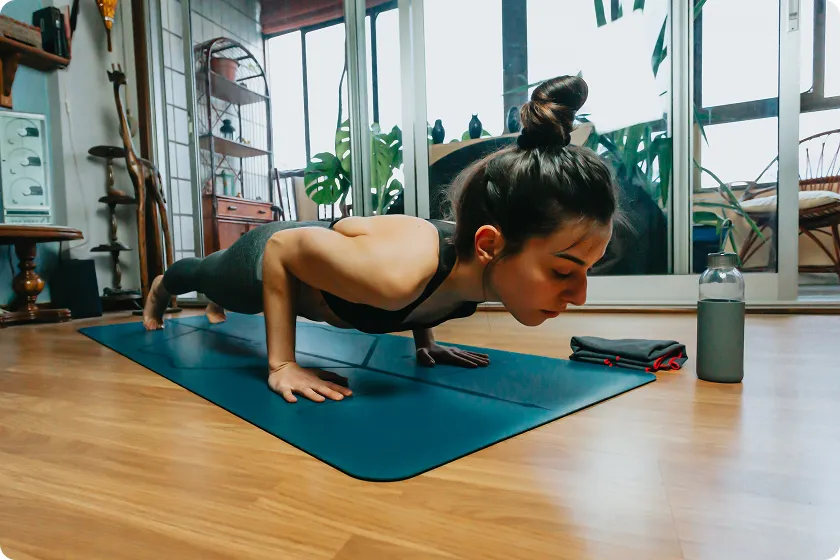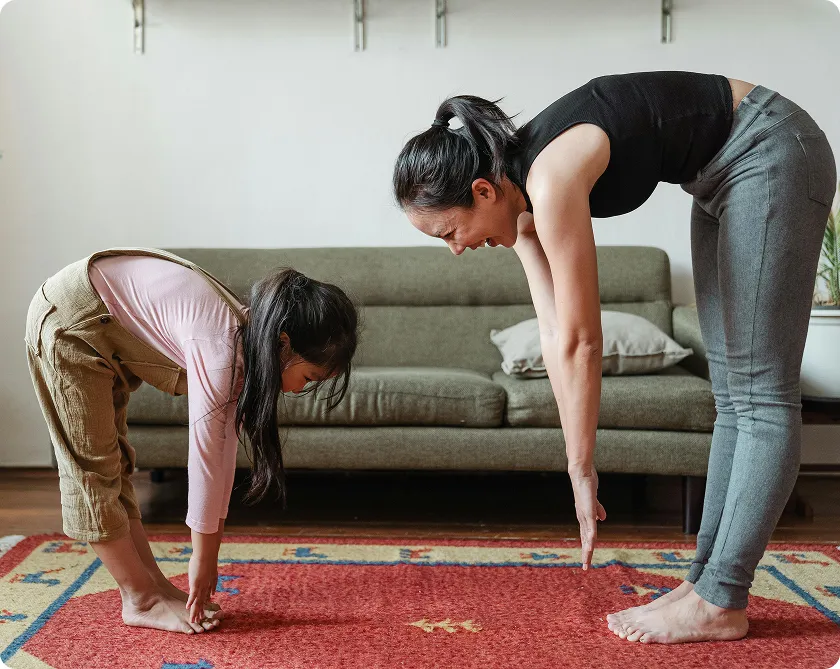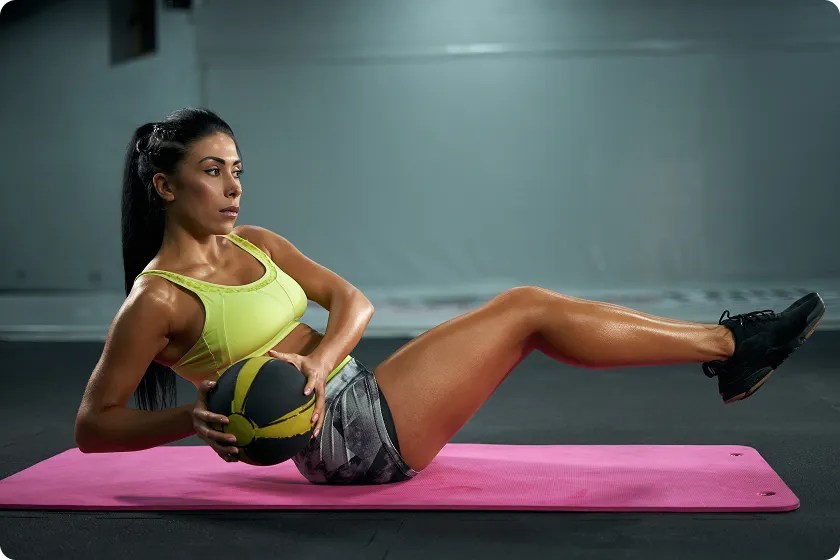Introduction: Why Your Daily Exercise Routine Matters
Have you ever vowed to start exercising tomorrow only to let that promise morph into weeks or even months? You are not alone yourself. While most of us are aware of the health benefits of exercise, establishing a consistent regimen can be challenging due to hectic schedules, a lack of motivation, or uncertainty about what to do.

A regular workout doesn’t have to be difficult, draining, or time-consuming, in actuality. Actually, if you follow the proper strategy, you may significantly increase your strength, vitality, mood, and long-term health with just 20 to 30 minutes a day. You can create a plan that works for you, regardless of whether you prefer the gym, exercise at home without equipment, or are a complete beginner. This guide will teach you:
The seven daily workouts for overall bodily health
- How to create an at-home, full-body exercise without any equipment
- An easy-to-follow gym routine to increase confidence and strength
- Daily workout advice to maintain motivation, consistency, and health
- A weekly exercise regimen that ties everything together.
By the end, you’ll have all you need to create your ideal daily exercise routine, one that is easy to follow, efficient, and long-lasting.
Why a Simple Daily Exercise Routine Matters for Your Health
Physical Benefits of a Daily Workout
Regular exercise increases muscular growth, flexibility, metabolism, and heart health. Moreover, regular exercise reduces your chance of developing long-term health issues, including high blood pressure, type 2 diabetes, and heart disease. A straightforward daily workout regimen, such as stretching, bodyweight training, or brisk walking, might have a noticeable impact.

Mental Health and Mood Enhancement
Exercise is not just good for your muscles; it’s also good for your brain. Due to the production of endorphins, sometimes referred to as “feel-good” chemicals, everyday exercisers report less stress, better sleep, and elevated mood, according to studies.
Long-Term Lifestyle Benefits
Consistency is the main benefit of sticking to a regimen. Daily exercise develops into a habit, just like brushing your teeth. That constancy over time creates resilience, vitality, and a lifetime of better living.
7 Exercises to Do Every Day for a Healthy Body
You don’t need fancy machines to build a strong body. These bodyweight workouts can be done anytime, anywhere:
Push-ups – Build upper body and core strength.

- Squats – Strengthen your legs and glutes.
- Planks – Improve core stability and posture.
- Lunges – Enhance balance and leg strength.
- Burpees – A full-body, fat-burning workout.
- Crunches – Strengthen abdominal muscles.
- Jumping jacks – Boost cardiovascular endurance.
Flexibility and Mobility Exercises
Including yoga postures or stretching helps to maintain healthy joints, increase mobility, and lower the chance of injury. Consider exercises like downward dog, cat-cow stretches, or basic hamstring stretches.
Quick Exercises to Do Every Day
Are you pressed for time? When your calendar is full, even 5–10 minutes of high knees, push-ups, or squats can help you stay on track. Never forget that something is always preferable to nothing.
Full Body Workout at Home Without Equipment
If fitness is new to you, begin with a mild routine:

- Ten squats
- Five modified push-ups
- Twenty leaping jacks
- 15-second plank
For a short, equipment-free workout at home that increases stamina and confidence, repeat two or three rounds.
An Effective Full Body Routine Using Only Bodyweight
Intermediate routine example:
- 20 squats
- 10 push-ups
- 15 lunges per leg
- 30-second plank
- 10 burpees
This full-body workout, which can be done without equipment, improves strength, endurance, and mobility.
Home Fitness Program No Equipment (30-Minute Plan)
Split your time into three chunks of ten minutes each:

- Cardio and warm-up exercises include mountain climbers and jumping jacks.
- Strength: Planks, lunges, and squats.
- Flexibility: static stretches or yoga.
Beginner-Friendly Gym Workout Plan for Building Strength
Strength Training Activities for Novice Gym Patrons. To learn appropriate form, start with machines or little free weights. Important exercises:
- Leg press
- The chest press
- Pull-down of the lat
- Shoulder press with dumbbells
- Rows of seats
A Beginner-Friendly Gym Workout Plan (3-Day Split Example)
- Day 1: Upper body exercises (chest press, tricep dips, and push-ups)
- Day 2: Lower body exercises (calf lifts, leg presses, and squats)
- Day 3: Cardio/full body exercises (bodyweight circuits, treadmill, rowing)
Weekly Workout Plan for Fitness (Sample Schedule)
- Strength exercise for three days
- Two days of aerobic exercise
- Active rehabilitation for two days, including yoga, gentle stretching, and walking.
Daily Exercise Tips for Health and Consistency
How to Stay Motivated
Establish modest, doable objectives, such as “I’ll do 10 minutes a day.” Keep a notebook or use an app to record your workouts since motivation increases when you see results.

Time Management: Fitting Workouts Into Busy Schedules. Short on time? Try:
- 10 squats before breakfast
- A brisk walk during lunch
- Stretching before bed
Small habits stack up into big results.
Healthy Lifestyle Habits That Support Exercise
Exercise is most effective when combined with stress reduction, hydration, a healthy diet, and adequate sleep. Consider them the cornerstones of your fitness.
Creating Your Best Daily Workout Plan
Balancing Cardio and Strength Training
While strength training alone may overlook endurance, excessive cardio can result in exhaustion. A mixture guarantees equilibrium:
- Two to three aerobic workouts every week
- Two to three strength training sessions.
- Daily stretches for flexibility
Combining Flexibility, Mobility, and Fat-Burning Workouts
A truly effective full-body routine includes stretching, strength, and high-intensity moves like burpees or sprints.
Customizing Your Workout Intensity
Goals determine the ideal daily exercise regimen for you:
- Weight reduction → increased aerobic and fat-burning exercise
- Strength → more resistance exercise
- Total fitness → well-balanced mixture
Common Mistakes Beginners Make (and How to Avoid Them)

Overtraining vs. Undertraining
Beginners often push too hard or too little. Aim for 20–45 minutes daily, adjusting intensity based on recovery.
Ignoring Warm-Up and Cool-Down
The risk of damage increases when warm-ups are skipped. Workouts become safer and more efficient with a basic 5-minute warm-up and cool-down.
Skipping Nutrition and Recovery
Exercise without proper nutrition or rest won’t deliver results. Focus on balanced meals and 7–9 hours of quality sleep.
Weekly Workout Plan for Fitness: Putting It All Together
Example Weekly Schedule for Beginners
- Monday: Full body home workout
- Tuesday: Brisk 30-minute walk
- Wednesday: Gym strength workout
- Thursday: Yoga/stretching
- Friday: Full body workout at home
- Saturday: Cardio fitness routine
- Sunday: Rest or light mobility work
Example Weekly Plan for Intermediate Fitness
- Monday: Gym upper body workout
- Tuesday: Interval cardio
- Wednesday: Lower body workout
- Thursday: Yoga/flexibility
- Friday: Full body HIIT routine
- Saturday: Cardio endurance (run, cycling)
- Sunday: Rest or light activity
Tracking Progress and Adjusting Over Time
Use a journal or fitness app to log workouts. If something feels too easy, increase reps or intensity. If too hard, reduce and build gradually.

Tracking Progress Beyond the Scale
A common error made by novices is to gauge their level of fitness just by their weight. Daily exercise improves posture, increases flexibility, develops lean muscle, and increases energy levels, all of which can help with fat reduction. Use performance benchmarks, such as the number of push-ups you can do, the amount of time you can hold a plank, or how much less exhausted you feel while ascending stairs, to monitor your progress rather than depending just on the scale. These non-scale successes help maintain motivation and frequently show development earlier.
The Role of Recovery in Daily Exercise
Although it’s simple to believe that more is usually better, relaxation and recuperation are just as crucial for outcomes. Your muscles sustain microscopic tears during exercise, which require time to heal and strengthen. You run the danger of exhaustion, overtraining, and even injury if you don’t rest. Walking, yoga, or gentle stretching are examples of active rehabilitation techniques that guarantee your body recharges while allowing you to continue with your regular schedule. Discipline, not weakness, is demonstrated by paying attention to your body and respecting rest days.
Making Exercise Enjoyable and Sustainable
Making fitness something you genuinely look forward to is one of the greatest ways to make it a lifelong habit. Investigate several forms of exercise until you discover what appeals to you; this might be dancing, hiking, kickboxing, cycling, or even group fitness programs. Adding diversity keeps things interesting and gives your body new challenges. Exercise becomes less of a hassle and more of a habit you’ll naturally maintain when you like the activity.

The Social Side of Fitness
Exercise every day doesn’t have to be a solitary endeavor. Workouts can be more enjoyable and accountable when done with a friend, in a local running club, or through online fitness challenges. In addition to keeping you motivated, social support offers consolation on difficult days. People who work out with others are much more likely to maintain their routine over time, according to research. Developing social ties around exercise, whether through a gym friend or an online group, may turn your routine into something you genuinely look forward to.
FAQ: Daily Exercise Routine – Your Questions Answered
1. What is the best daily workout plan for beginners?
Start with short sessions (15–20 minutes), focusing on bodyweight moves like squats, push-ups, and planks. Build gradually into a balanced weekly workout plan for fitness.
2. Can I get fit with a full body workout at home without equipment?
Yes! Bodyweight exercises like lunges, planks, and burpees build strength, endurance, and mobility without any equipment.
3. How long should a simple daily exercise routine take?
Even 20–30 minutes a day is enough for most people to see benefits. Consistency matters more than duration.
4. What are some easy home workouts for beginners?
Squats, modified push-ups, planks, and jumping jacks make excellent easy home workouts for beginners
5. Should I follow a gym workout plan or home fitness program?
It depends on your goals and lifestyle. A home workout with no equipment is convenient, while a gym workout plan may provide more variety.
6. What are quick exercises to do everyday if I only have 10 minutes?
Squats, push-ups, planks, and jumping jacks. Even 10 minutes daily adds up to meaningful results.
Conclusion: Start Your Daily Exercise Routine Today
Exercise doesn’t have to be difficult or time-consuming. Consistency is crucial, regardless of whether you opt for a beginner-friendly gym workout plan, a comprehensive home workout, or a daily exercise routine.
Recall that exercise fosters a healthy lifestyle, energizes your body, and sharpens your intellect. You will quickly discover that you are stronger, more energized, and more self-assured if you begin with modest, doable steps.




